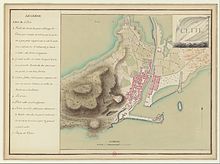Canal Royal
The Canal Royal (also: Canal de Sète ) is a shipping canal in France . It represents the connection between the Mediterranean Sea and the lagoon Étang de Thau in Languedoc . It was built as an eastern continuation of the Canal royal en Languedoc (today: Canal du Midi ) which flows into the lagoon at Marseillan .
description
The almost 2.1 km long canal lies entirely in the area of the southern French city of Sète . The section between the two bridges Pont de la Civette and Pont de la Savonnerie is called "Cadre Royal". Every year the tournaments called “Joutes” take place there, a fighting game between two parties, each consisting of sixteen seamen (the “Reds” and the “Blue”) in their boats.
Two other canals lead off the Canal Royal in an easterly direction: the Canal de la Peyrade as an extension of the Canal du Rhône à Sète , to the north of it, the Canal Latéral leads to the marina Bassin du Midi and from 1839 parallel to the Canal Royal Canal Maritime.
The canal is crossed with five road bridges and one railway bridge. The two most northerly, the bridge of the double-track, electrified main line Bordeaux – Sète and the nearby road bridge Pont Sadi Carnot are designed as bascule bridges . They can be opened for the passage of larger ships; those sail south of it on the Canal Latéral and the Canal Maritime.
history

Pierre-Paul Riquet , the builder of the Canal du Midi, found the right place at Cap de Sète to connect it to the Mediterranean. At the same time, Louis Nicolas de Clerville , who was looking for a suitable building site for a port on behalf of the royal minister Jean-Baptiste Colbert , suggested that it be built at the foot of the 175 m high Mont Saint-Clair . In May 1663, Riquet presented his plans to Colbert, which Louis XIV approved in an edict in early October 1666 . The contract for the construction of the canal from the Étang de Thau to the Mediterranean Sea at the port of Sète - today's Canal Royal - as well as the expansion of the port itself was awarded to Riquet in 1669.
Work on the port began on July 29, 1666, first of all the 650 m long stone pier "Saint Louis" was built in the sea. The Canal Royal is already shown on a map from 1682. In 1708, the port, now protected by fortifications designed by Antoine Niquet , a student of Vauban , was completed.
The town of Sète developed on the north side of the harbor basin and on both sides of the Canal Royal.
Web links
Individual evidence
- ↑ Sète: une ville, un port at canaldumidi.com, accessed on January 7, 2019
- ↑ Le cadre Royal at sete.fr, accessed on January 7, 2019
- ↑ Le Cadre Royal at de.tourisme-sete.com, accessed on January 7, 2019
- ↑ a b Fondation du port de Sète et début du creusement du canal royal des Deux-Mers at francearchives.fr, accessed on 7 January 2019
- ↑ Histoire de Sète at de.tourisme-sete.com, accessed on January 7, 2019
- ↑ a b Un peu d'histoire at sete.port.fr, accessed on January 7, 2019
- ↑ Histoire de Sète at persee.fr, accessed on January 7, 2019

